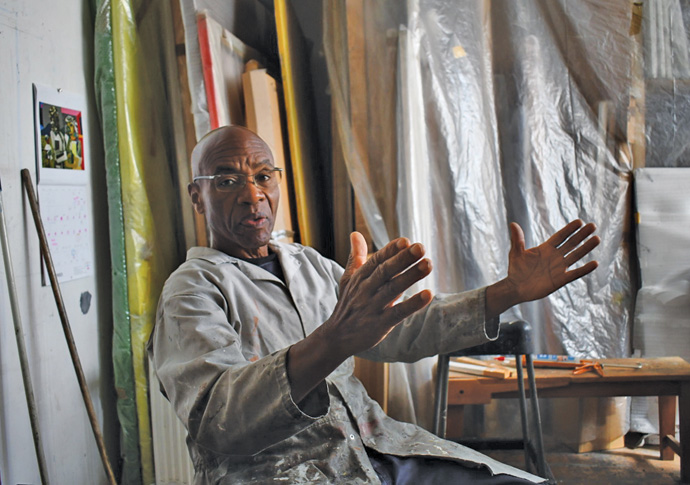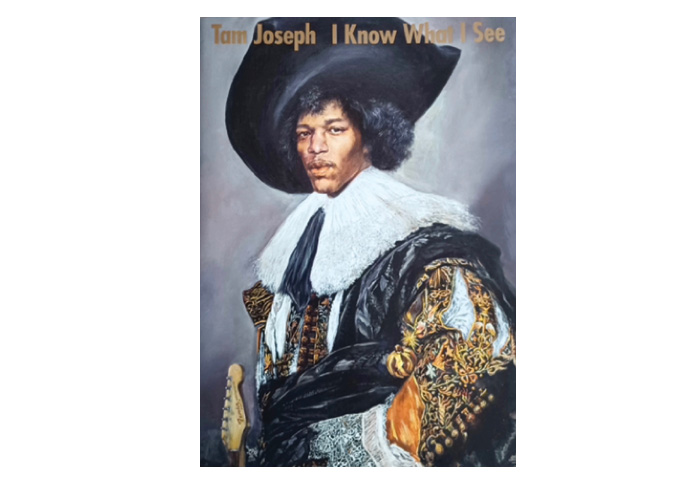‘I do what I want’
Angela Cobbinah talks to inspirational artist and sculptor Tam Joseph about his extraordinary 40-year career
Thursday, 23rd November 2023 — By Angela Cobbinah

Tom Joseph in Walthamstow [Spencer Richards]
AS a schoolboy in Islington in the 1950s, the painter and sculptor Tam Joseph stood out for his exceptional talent. “One day during woodwork I carved a little totem figure and I remember my teacher asking me in astonishment: ‘Who taught you to do that?’ I said: ‘No one. I just know how to do it,’” he recalls, adding: “I just did things that came naturally to me.”
Inspired as much by Popeye and Miles Davis as he is by Rembrandt and Picasso, that is exactly what he’s been doing over the past 40 years, producing work that has found its way into the collections of Tate Modern and the V&A but somehow defies neat categorisation because of its shifting subject matter and style.
When it comes to materials, it can range from conventional canvas to discarded chipboard; basically, whatever takes his fancy.
But it has been a long and winding road and it is only now that the length and breadth of his freewheeling practice was being finally acknowledged, with an “in-conversation” slot at the V&A last week and the launch a couple of months earlier of the lavishly produced monograph, Tam Joseph: I Know What I See.
The cover sleeve showcases Living Legend with Stratocaster, Joseph’s glorious rendition of one of his favourite portraits, Laughing Cavalier by the 17th-century Dutch artist Frans Hals, in which Jimi Hendrix now takes centre stage, clutching his guitar.
“I looked at this happy man, who is calm in his wealth and radiating confidence, and I thought about Jimi Hendrix… I wanted to make time collide,” he explains.
The two paintings Joseph is most associated with, UK School Report and Spirit of Carnival, both pungent observations of black people’s place in British society, were produced four decades earlier, in the early 80s, but blanked by the art world.
“They got totally ignored at the time,” he recalls with evident frustration. “Now I ask myself, why are you exhibiting stuff I did 40 years ago? Art is for now and these works would have had more power if they had been shown in the 1980s, when they really meant something. Now they are like a tiger without teeth.”

The cover of Joseph’s monograph which showcases Living Legend with Stratocaster
His recent solo show at the Felix & Spear Gallery in Ealing, Beam Me Up, Sweet Lord, gave us a mini retrospective of his career, with a display of 13 sculptures and paintings from the 1980s to the present, some firmly rooted in political commentary like J Edgar Hoover: The Murder of Fred Hampton (tissue paper, iron filings, photograph), others created for the fun of it like Mon Petit Micoux (papier-mâché and bark), a celebration he says of the “African woman’s bum”, while his moving 2022 study of Len Johnson, the between-the-wars boxing star who was banned from contesting the British middleweight title because of his colour, exemplifies his remarkable talent as a portraitist and a painter.
Restless, curious and single-minded, he just refuses to be typecast. “I do what I want. I am not there to please others or cause fear in the minds of white people,” he declares. “I look at something and reinterpret it in the best way I can so that everyone can see what I see, that is my aim.”
Art has been in his life since he was a small boy growing up in Dominica. “Some people loved playing around with a ball. Me, I just loved playing around with pencils, paper and paint,” he says.
The father-of-two came to England in 1955 aged eight, settling in Highbury and attending Drayton Park Primary and Barnsbury Boys’ Secondary. Around 13, he became fascinated with cartoons and would make little flip books from laundry ticket stubs and sell them to his schoolmates. But he would also spend time in Central Library in Holloway Road reading up on art history. Another haunt was the Wallace Collection in Marylebone to gaze upon the Old Masters and armoury displays.
A few years later, he joined the legendary Islington Art Circle, where he developed his skills with life drawing classes.
Art school beckoned but he only applied after being encouraged to do so by Animal Farm animators Halas and Batchelor, whom he’d gone to for a job. After taking a foundation course at the Central School of Art and Design in 1966, he got a coveted place at the Slade, but didn’t stick around long, finding it “boring”.
After a stint working as a painter and tracer on Yellow Submarine, he went on his travels, across Europe and to India via Afghanistan, then knuckled down to study typographic design at the London College of Printing in 1973. That same year he started volunteering at the Keskidee Centre off Caledonian Road, famed for being Britain’s first black arts centre, and threw himself into painting stage sets.
The 70s saw the emergence of the influential Blk Art Group that was to bring the work of young black artists to the fore. Typically, Joseph did not join but took inspiration from it, as well as a period of travel to West Africa, executing some of his early in-your-face paintings on the bedroom wall of his home in Turnpike Lane, where he still lives with his wife, Françoise.
Numerous exhibitions followed, culminating group-wise in Life Between Islands at Tate Britain in 2021. Now after a whirlwind year, he is busy in one of his favourite places, his studio in Blackhorse Lane, Walthamstow, working on his latest artistic adventure.
• Tam Joseph: I Know What I See, Four Corners Books, £25